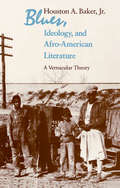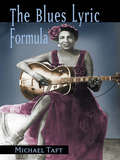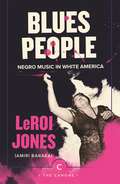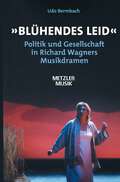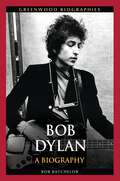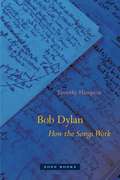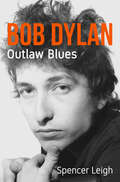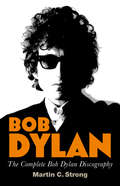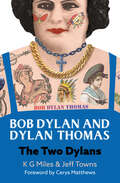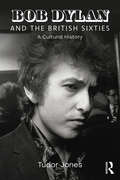- Table View
- List View
Blues Harmonica For Dummies
by Winslow YerxaBlues Harmonica For Dummies (9781119694519) was previously published as Blues Harmonica For Dummies (9781118252697). While this version features a new Dummies cover and design, the content is the same as the prior release and should not be considered a new or updated product.
Blues Harmonica For Dummies
by Winslow YerxaBlues Harmonica For Dummies (9781119694519) was previously published as Blues Harmonica For Dummies (9781118252697). While this version features a new Dummies cover and design, the content is the same as the prior release and should not be considered a new or updated product.
Blues Harmonica For Dummies
by Winslow YerxaBreathe the blues into your harmonica Learn about bending, tongue blocking, and chordal rhythm Connect with blues history and the major players The fun and easy way to play blues harmonica Blues Harmonica For Dummies gives you a wealth of guidance on playing harmonica in the style of the blues masters. Learn how to go from playing easy chords to strong single notes — and then to 12-bar blues. Develop your personal style and put together a repertoire of tunes to play for an audience. Explore specific techniques and applications, including bending and making your notes sound richer and fuller; using amplification; developing blues licks and riffs; performing a blues harmonica solo like a pro; and much more. Inside... A review of the blues as a musical style What it takes to get started A blues guide to music symbols Ways to shape, color, and punctuate your blues sound How to amplify your playing Important blues players and recordings
Blues Harmonica For Dummies
by Winslow YerxaBreathe the blues into your harmonica Learn about bending, tongue blocking, and chordal rhythm Connect with blues history and the major players The fun and easy way to play blues harmonica Blues Harmonica For Dummies gives you a wealth of guidance on playing harmonica in the style of the blues masters. Learn how to go from playing easy chords to strong single notes — and then to 12-bar blues. Develop your personal style and put together a repertoire of tunes to play for an audience. Explore specific techniques and applications, including bending and making your notes sound richer and fuller; using amplification; developing blues licks and riffs; performing a blues harmonica solo like a pro; and much more. Inside... A review of the blues as a musical style What it takes to get started A blues guide to music symbols Ways to shape, color, and punctuate your blues sound How to amplify your playing Important blues players and recordings
Blues, How Do You Do?: Paul Oliver and the Transatlantic Story of the Blues
by Christian O'ConnellRecent revisionist scholarship has argued that representations by white “outsider” observers of black American music have distorted historical truths about how the blues came to be. While these scholarly arguments have generated an interesting debate concerning how the music has been framed and disseminated, they have so far only told an American story, failing to acknowledge that in the post-war era the blues had spread far beyond the borders of the United States. As Christian O’Connell shows in Blues, How Do You Do? Paul Oliver’s largely neglected scholarship—and the unique transatlantic cultural context it provides—is vital to understanding the blues. O’Connell’s study begins with Oliver’s scholarship in his early days in London as a writer for the British jazz press and goes on to examine Oliver’s encounters with visiting blues musicians, his State Department–supported field trip to the US in 1960, and the resulting photographs and oral history he produced, including his epic “blues narrative,” The Story of the Blues (1969). Blues, How Do You Do? thus aims to move away from debates that have been confined within the limits of national borders—or relied on clichés of British bands popularizing American music in America—to explore how Oliver’s work demonstrates that the blues became a reified ideal, constructed in opposition to the forces of modernity.
Blues, Ideology, and Afro-American Literature: A Vernacular Theory
by Houston A. Baker, Jr.Relating the blues to American social and literary history and to Afro-American expressive culture, Houston A. Baker, Jr., offers the basis for a broader study of American culture at its "vernacular" level. He shows how the "blues voice" and its economic undertones are both central to the American narrative and characteristic of the Afro-American way of telling it.
The Blues Lyric Formula
by Michael TaftThis book is the first rigourous and detailed exploration of exactly how blues singers used formulas to create songs, and it more than amply fills the gap in the the study of the blues, where the structure and content of the lyrics have been less fully explored than the musical form. Focusing on the songs recorded by African-American singers for pre-World War Two commercial recording companies, this is an excellent structural analysis of the formulaic composistion of blues lyrics. This book gives a step-by-step description of the rules implicit in this formulaic structure and inspires new discussion of lyric structures. A wide array of readers will find this insightful and informative: from students of African-American music, cultural studies, history and linguistics, to Blues fans fascinated by exactly how the lyrics of this influential music style are written.
The Blues Lyric Formula
by Michael TaftThis book is the first rigourous and detailed exploration of exactly how blues singers used formulas to create songs, and it more than amply fills the gap in the the study of the blues, where the structure and content of the lyrics have been less fully explored than the musical form. Focusing on the songs recorded by African-American singers for pre-World War Two commercial recording companies, this is an excellent structural analysis of the formulaic composistion of blues lyrics. This book gives a step-by-step description of the rules implicit in this formulaic structure and inspires new discussion of lyric structures. A wide array of readers will find this insightful and informative: from students of African-American music, cultural studies, history and linguistics, to Blues fans fascinated by exactly how the lyrics of this influential music style are written.
Blues People (Canons)
by LeRoi JonesIn this essential and impassioned text, LeRoi Jones traces the intertwined development of blues and jazz music with the history of its creators in ‘White America’. As important and relevant as at its first publication in 1963, it shows how music and its people are inseparable – expressing and reflecting the other, surviving and adapting through oppression.
"Blühendes Leid": Politik und Gesellschaft in Richard Wagners Musikdramen
by Udo BermbachVon den frühen Opern bis zum Parsifal . Kaum ein Künstler der Moderne hat so entschieden auf dem Zusammenhang von Politik, Gesellschaft und Kunst bestanden wie Richard Wagner und sein Werk daher eingehend kommentiert. Vor dem Hintergrund von Wagners theoretischen Schriften spürt der Autor in dessen Werken politischen und gesellschaftlichen Inhalten nach und erläutert den zeitgenössischen Kontext. Auch die immer wieder gestellte Frage nach dem Antisemitismus in Wagners großen Musikdramen wird beantwortet.
Bob Dylan: A Biography (Greenwood Biographies)
by Bob BatchelorBob Dylan transcends music. He has established himself as one of the most important figures in entertainment history. This biography examines the life and work of the iconic artist, including his groundbreaking achievements of the last two decades.In this thematically organized biography, cultural historian and prolific biographer Bob Batchelor examines one of the most important yet elusive figures in modern history. Rather than taking an exhaustive and cumbersome chronological approach to Bob Dylan's 50-plus year career, the author focuses on the most significant aspects of his life and accomplishments. This work examines the musician's life and career by placing him in the context of contemporary American history and culture. Dylan's music and lyrics are at the center of the analysis, while attention is also paid to how his image transformed as he moved from being the "voice of a generation" during the 1960s to becoming a bonafide rock and roll icon. Readers will appreciate the book for its in-depth, scholarly coverage that remains readable and engaging, and gain a full appreciation for Dylan's place in American history and cultural evolution.
Bob Dylan: A Biography (Greenwood Biographies)
by Bob BatchelorBob Dylan transcends music. He has established himself as one of the most important figures in entertainment history. This biography examines the life and work of the iconic artist, including his groundbreaking achievements of the last two decades.In this thematically organized biography, cultural historian and prolific biographer Bob Batchelor examines one of the most important yet elusive figures in modern history. Rather than taking an exhaustive and cumbersome chronological approach to Bob Dylan's 50-plus year career, the author focuses on the most significant aspects of his life and accomplishments. This work examines the musician's life and career by placing him in the context of contemporary American history and culture. Dylan's music and lyrics are at the center of the analysis, while attention is also paid to how his image transformed as he moved from being the "voice of a generation" during the 1960s to becoming a bonafide rock and roll icon. Readers will appreciate the book for its in-depth, scholarly coverage that remains readable and engaging, and gain a full appreciation for Dylan's place in American history and cultural evolution.
Bob Dylan: How the Songs Work
by Timothy HamptonA career-spanning account of the artistry and politics of Bob Dylan’s songwritingBob Dylan’s reception of the 2016 Nobel Prize for Literature has elevated him beyond the world of popular music, establishing him as a major modern artist. However, until now, no study of his career has focused on the details and nuances of the songs, showing how they work as artistic statements designed to create meaning and elicit emotion. Bob Dylan: How the Songs Work (originally published as Bob Dylan's Poetics) is the first comprehensive book on both the poetics and politics of Dylan’s compositions. It studies Dylan, not as a pop hero, but as an artist, as a maker of songs. Focusing on the interplay of music and lyric, it traces Dylan’s innovative use of musical form, his complex manipulation of poetic diction, and his dialogues with other artists, from Woody Guthrie to Arthur Rimbaud. Moving from Dylan’s earliest experiments with the blues, through his mastery of rock and country, up to his densely allusive recent recordings, Timothy Hampton offers a detailed account of Dylan’s achievement. Locating Dylan in the long history of artistic modernism, the book studies the relationship between form, genre, and the political and social themes that crisscross Dylan’s work. Bob Dylan: How the Songs Work offers both a nuanced engagement with the work of a major artist and a meditation on the contribution of song at times of political and social change.
Bob Dylan: How the Songs Work
by Timothy HamptonA career-spanning account of the artistry and politics of Bob Dylan’s songwritingBob Dylan’s reception of the 2016 Nobel Prize for Literature has elevated him beyond the world of popular music, establishing him as a major modern artist. However, until now, no study of his career has focused on the details and nuances of the songs, showing how they work as artistic statements designed to create meaning and elicit emotion. Bob Dylan: How the Songs Work (originally published as Bob Dylan's Poetics) is the first comprehensive book on both the poetics and politics of Dylan’s compositions. It studies Dylan, not as a pop hero, but as an artist, as a maker of songs. Focusing on the interplay of music and lyric, it traces Dylan’s innovative use of musical form, his complex manipulation of poetic diction, and his dialogues with other artists, from Woody Guthrie to Arthur Rimbaud. Moving from Dylan’s earliest experiments with the blues, through his mastery of rock and country, up to his densely allusive recent recordings, Timothy Hampton offers a detailed account of Dylan’s achievement. Locating Dylan in the long history of artistic modernism, the book studies the relationship between form, genre, and the political and social themes that crisscross Dylan’s work. Bob Dylan: How the Songs Work offers both a nuanced engagement with the work of a major artist and a meditation on the contribution of song at times of political and social change.
Bob Dylan: Outlaw Blues
by Spencer LeighBob Dylan: Outlaw Blues by Spencer Leigh is a fresh take on this famous yet elusive personality, a one-man hall of mirrors who continues to intrigue his followers worldwide.It is an in-depth account with new information and fascinating opinions, both from the author and his interviewees. Whether you are a Dylan fan or not, you will be gripped by this remarkable tale.Most performers create their work for public approval, but at the centre of this book is a mercurial man who doesn't trust his own audience. If he feels he is getting too much acclaim, he tends to veer off in another direction. Despite his age, Bob Dylan still tours extensively. Famously known for not looking happy, the author looks at what motivates him. 'Journalists are very fond of saying Bob Dylan is an enigma,' says Spencer Leigh, 'but that word is flawed. It's as good as saying you don't know... I have not called Bob Dylan an enigma at any point in the book as I have tried to find answers.'Spencer Leigh has spoken to over 300 musicians, friends and acquaintances of Bob Dylan in his research for this book.
Bob Dylan: Writings 1968-2010
by Greil MarcusHis foremost interpreter revisits more than forty years of listening to Dylan - weaving individual moods and moments into a brilliant history of their changing times. The book begins in Berkeley in 1968, and ends with a piece on Dylan's show at the University of Minnesota on election night 2008. In between are moments of euphoric discovery: from Marcus' sleeve notes for the 1967 Basement Tapes to his exploration of Dylan's reimagining of the American experience in 1997's Time Out of Mind. And rejection; Marcus's Rolling Stone piece on Dylan's album Self Portrait -- often referred to as the most famous record review ever written -- began with 'What is this shit?' and led to his departure from the magazine for five years. Marcus follows not only recordings but performances. books, movies, and all manner of highways and byways in which Bob Dylan has made himself felt in our culture. Together, the dozens of pieces collected here comprise a portrait of how, throughout his career, Bob Dylan has drawn upon and reinvented the landscape of American song, its myths and choruses, heroes and villains. They are the result of more than forty years' engagement between an unparalleled artist and a uniquely acute listener.
Bob Dylan: The Complete Discography
by Martin C. StrongBob Dylan: The Complete Bob Dylan Discogrpahy contains all you will ever need to know about Bob Dylan and his releases. Including an expansive biography, album reviews and comprehensive discography, it is an invaluable guide for Dylan fans everywhere.This is an essential purchase for all lovers of Bob Dylan, with details of everything the legendary singer/songwriter produced.
Bob Dylan and Dylan Thomas: The Two Dylans
by Jeff Towns K G MilesThere are so many strange and wonderful connections and coincidences; shared passions and associations that tie these two cultural icons – BOB DYLAN and DYLAN THOMAS together.This provides a rich tapestry – from the ancient Welsh folk tales of the Mabinogion to the poems of the Beat Generation; from Stravinsky to John Cale; from Johnny Ray to Charlie Chaplain. Rimbaud and Lorca, Sgt Pepper and The Bells of Rhymney, Nelson Algren and Tennessee Williams and much more. And the wonderful connections between authors K G Miles and Jeff Towns makes it the perfect partnership to write this book.Fifty-two years ago, author Jeff Towns opened his first bookstore in Swansea – he called it Dylans Bookshop – a youthful homage to the poet Dylan Thomas born and raised in Swansea, an author he admired. Eight years before that, in 1962, (when he had never really heard of Dylan Thomas), he had bought his first ever LP record, Bob Dylan's first ever LP release calledBob Dylanwith a track list; In My Time of Dyin', Fixin' to Die, See That My Grave is Kept Clean and so on; baker's dozen of powerful songs. Jeff read that his new hero had been born Robert Zimmerman but had changed his name to BOB DYLAN, a homage to a Welsh poet named DYLAN THOMAS.From that moment on THE TWO DYLANS became a constant part of and backdrop to his life. And the two Dylans kept on giving – they were both on the cover of the Beatles Sgt Pepper album. Peter Blake who fashioned the cover of Pepper, was a huge fan on Dylan Thomas' radio play Under Milk Wood. Jeff went to see Peter, they became friends and still are. Peter gave permission to use his wonderfulTiny Tina the Tattooed Lady©Peter Blake image for the cover of this book.London co-author K G Miles has been inspired by BOB DYLAN since being an awestruck child at Bob's Isle of Wight Festival in 1969. He is now the co-curator the of theDylan Room at London's Troubadour Cluband was honoured to address the inaugural conference at the Tulsa Archive in 2019.
Bob Dylan and Leonard Cohen: Deaths and Entrances
by David Boucher Lucy BoucherBoth Dylan and Cohen have been a presence on the music and poetry landscape spanning six decades. This book begins with a discussion of their contemporary importance, and how they have sustained their enduring appeal as performers and recording artists. The focus then returns to their ambitions when they first started out, arguing that they both shared the aspirations of the Beat Generation of Ginsberg, Kerouac and Corso to be as famous as Dylan Thomas and live the life of his sense of unconditional social irresponsibility. The 'Rimbaud of Cwmdonkin Drive' took America by storm, demonstrating that the bohemian poet could earn a living outside the academy. The fame of Dylan and Cohen, while it fluctuated over the decades, was sustained and was sustainable because they self-consciously adopted different personas, or masks, to distance themselves from the public self. This necessarily requires an exploration of their relation to religion as avenues to find and preserve their inner identities. Their lyrics and poetry are explored in the context of the relation between poetry and song, and of Lorca's concepts of the poetry of inspiration, and the deep dark emotional depths of 'duende.' Such ideas draw upon the dislocation of the mind, and the liberation of the senses that so struck Dylan and Cohen when they first read the poetry and letters of Arthur Rimbaud and Federico García Lorca. We see that the performance and the poetry are integral, and the 'duende,' or passion, of the delivery, is inseparable from the lyric or poetry, and common to Dylan, Cohen and the Beat Generation.
Bob Dylan and Leonard Cohen: Deaths and Entrances
by David Boucher Lucy BoucherBoth Dylan and Cohen have been a presence on the music and poetry landscape spanning six decades. This book begins with a discussion of their contemporary importance, and how they have sustained their enduring appeal as performers and recording artists. The focus then returns to their ambitions when they first started out, arguing that they both shared the aspirations of the Beat Generation of Ginsberg, Kerouac and Corso to be as famous as Dylan Thomas and live the life of his sense of unconditional social irresponsibility. The 'Rimbaud of Cwmdonkin Drive' took America by storm, demonstrating that the bohemian poet could earn a living outside the academy. The fame of Dylan and Cohen, while it fluctuated over the decades, was sustained and was sustainable because they self-consciously adopted different personas, or masks, to distance themselves from the public self. This necessarily requires an exploration of their relation to religion as avenues to find and preserve their inner identities. Their lyrics and poetry are explored in the context of the relation between poetry and song, and of Lorca's concepts of the poetry of inspiration, and the deep dark emotional depths of 'duende.' Such ideas draw upon the dislocation of the mind, and the liberation of the senses that so struck Dylan and Cohen when they first read the poetry and letters of Arthur Rimbaud and Federico García Lorca. We see that the performance and the poetry are integral, and the 'duende,' or passion, of the delivery, is inseparable from the lyric or poetry, and common to Dylan, Cohen and the Beat Generation.
Bob Dylan and the British Sixties: A Cultural History
by Tudor JonesBritain played a key role in Bob Dylan's career in the 1960s. He visited Britain on several occasions and performed across the country both as an acoustic folk singer and as an electric-rock musician. His tours of Britain in the mid-1960s feature heavily in documentary films such as D.A. Pennebaker's Don't Look Back and Martin Scorsese's No Direction Home and the concerts contain some of his most acclaimed ever live performances. Dylan influenced British rock musicians such as The Beatles, The Animals, and many others; they, in turn, influenced him. Yet this key period in Dylan's artistic development is still under-represented in the extensive literature on Dylan. Tudor Jones rectifies that glaring gap with this deeply researched, yet highly readable, account of Dylan and the British Sixties. He explores the profound impact of Dylan on British popular musicians as well as his intense, and at times fraught, relationship with his UK fan base. He also provides much interesting historical context – cultural, social, and political – to give the reader a far greater understanding of a defining period of Dylan's hugely varied career. This is essential reading for all Dylan fans, as well as for readers interested in the tumultuous social and cultural history of the 1960s.
Bob Dylan and the British Sixties: A Cultural History
by Tudor JonesBritain played a key role in Bob Dylan's career in the 1960s. He visited Britain on several occasions and performed across the country both as an acoustic folk singer and as an electric-rock musician. His tours of Britain in the mid-1960s feature heavily in documentary films such as D.A. Pennebaker's Don't Look Back and Martin Scorsese's No Direction Home and the concerts contain some of his most acclaimed ever live performances. Dylan influenced British rock musicians such as The Beatles, The Animals, and many others; they, in turn, influenced him. Yet this key period in Dylan's artistic development is still under-represented in the extensive literature on Dylan. Tudor Jones rectifies that glaring gap with this deeply researched, yet highly readable, account of Dylan and the British Sixties. He explores the profound impact of Dylan on British popular musicians as well as his intense, and at times fraught, relationship with his UK fan base. He also provides much interesting historical context – cultural, social, and political – to give the reader a far greater understanding of a defining period of Dylan's hugely varied career. This is essential reading for all Dylan fans, as well as for readers interested in the tumultuous social and cultural history of the 1960s.
Bob Dylan In America
by Sean WilentzA brilliantly written and groundbreaking book about Dylan's music – now the recipient of the Nobel Prize for Literature 2016 – and its musical, political and cultural roots in early 20th-century AmericaGrowing up in Greenwich Village in the 1960s Sean Wilentz discovered the music of Bob Dylan as a young teenager. Almost half a century later, now a distinguished professor of American history, he revisits Dylan's work with the critical skills of a scholar and the passion of a fan. Drawing partly on his work as the current historian-in-residence on Dylan's official website, Sean Wilentz provides a unique blend of biography, memoir and analysis in a book which, much like its subject, shifts gears and changes shape as the occasion demands.
Bob Dylan in London: Troubadour Tales
by K G Miles Jackie LeesThis is a wonderful guide and a history of the impact London had on Bob Dylan, and the lasting legacy Bob Dylan had on the London music scene. Follow in his footsteps exploring key London places that influenced one of the greatest of all popular musicians.Meticulously researched and packed with delicious detail, this highly enjoyable book reveals both Bob Dylan and London in all of their compelling originality. With wry observation and entertaining incident, this is the story of Dylan's earliest visits to London as an unknown folk singer, crashing in friends’ bedsits, right through to his sell-out concerts at the Royal Albert Hall and Earls Court.
Bob Dylan in the Big Apple: Troubadour Tales of New York (Troubadour Tales #2)
by K G MilesThis is your travel guide through time and space to the favorite haunts of the most celebrated folkie on planet earth. Bob Dylan in the Big Apple takes you on Dylan's journey through the streets of New York - the locations, characters and stories that formed a backdrop to his life and work.Follow in his early footsteps to the Cafe Wha? and more recently the Beacon Theatre. With maps, illustrations and wonderful stories this is a must have for any Dylan enthusiast.


